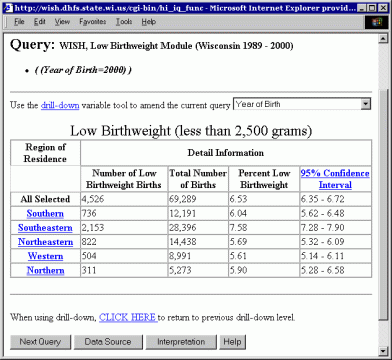WISH: Construct a Query
A step-by-step example using the low birthweight module
Within each module of the WISH system you begin a query by deciding "Which measure do you wish to focus on?" The choice you make creates a central data construct from which additional query options are possible (e.g., by geographic areas, by year groupings, by maternal or infant characteristics). In the Low Birthweight Module you can focus on any of eight measures:
- Low birthweight (<2,500 grams)
- Very low birthweight (<1,500 grams)
- Extremely low birthweight (<1,000 grams)
- Premature birth (<37 weeks gestation)
- Premature (<37 weeks gestation) low birthweight (<2,500 grams)
- Term (37+ weeks gestation) low birthweight (<2,500 grams) Birthweight 2,500 grams or more
- Total number of births
At this point you have selected a data measure. You may SUBMIT your request now or further specify query criteria. Submitting a request at this point creates output for Wisconsin statewide for the latest year of stored data. This gives a quick, broad view of the data measure you requested. However, you may also customize the query by selecting additional criteria.
When the output table is displayed, you may print it using your browser print features. Here is an example output table:
Using the Drill-Down Feature
Using drill-down to amend the current query is a bit confusing at first, but with a bit of trial-and-error it gives you a way to obtain additional information from the query you submitted.
Drill-down allows you to focus on just one category of the variable you have already selected (either a single row or a single column ). To use drill-down, first select an additional variable from the drop-down list box above your current output table:
The sample output table above shows where the drill-down box appears (at the top of the table). To use the drill-down feature, click on one of the rows (or columns) to see results for just that row (or column).
Note that the subject of the table (such as low birthweight) remains the same. Drill-down permits you to see that measure for a more narrowly focused group.
A new table is generated each time you choose a drill-down variable and click on a row (or column). You can use drill-down repeatedly on a query, choosing an additional variable each time, although you may become confused as you lose reference to the initial query. Note: The drill-down feature is not available for all queries.
Start a totally fresh query within the same module by clicking . You will return to the step-by-step query process.
Other options shown on an output table include . These provide additional information and explanation for reading output from your query.

